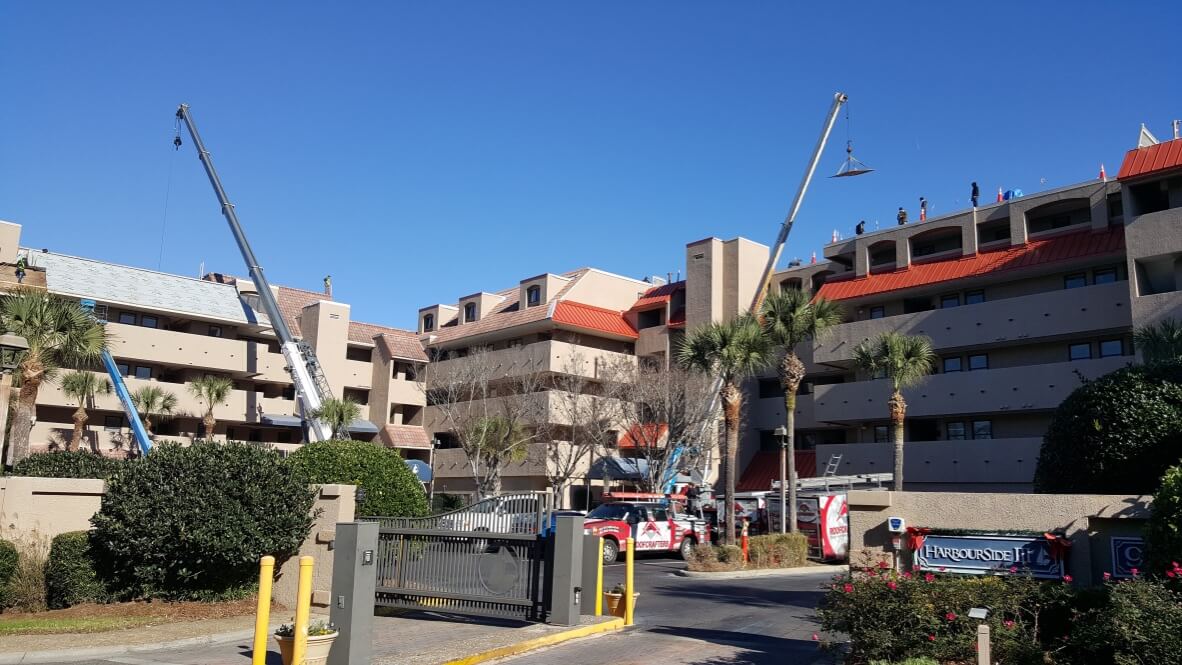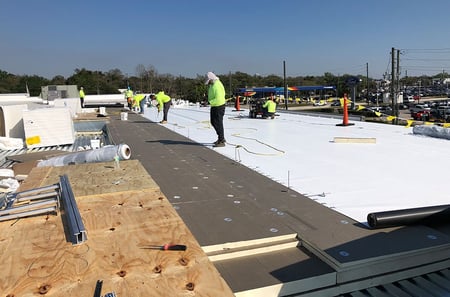Understanding Commercial Roof Replacement Costs
July , 2024 | 6 min. read

Do you have an older commercial property that's almost due for a new roof? Maybe you've been dealing with some pesky leaks and know it’s time for a full commercial roof replacement. Well, you're in the right place! We understand that browsing the internet for roof replacement costs can feel like navigating through a maze. But rest assured, you’re not lost in space; you’ve landed in the perfect spot.
For over three decades, RoofCrafters has been designing and performing commercial roof replacements, so we know exactly what they cost and are eager to share our expertise. In this article, we’ll cover:
- The three types of commercial roof structures
- The five most common types of commercial roof systems
- The average cost for a commercial roof system
By the end of this article, you’ll be well-informed about commercial roof replacement, helping you make the best decision for your property. Let's dive right in!
Exploring Types of Commercial Roof Constructions

A commercial roofing design is extremely important when dealing with flat roof construction. Sloped roof options are more like residential. There are 3 main types of roof designs used for constructing a commercial building.
- Flat roof commercial construction
- Low-slope commercial construction
- Steep slope commercial construction
The Essentials of Flat Roof Construction for Commercial Properties

Flat roofs are common in commercial buildings, offering advantages like easy installation of rooftop equipment and reduced structural requirements. Proper installation requires tapered insulation to prevent water pooling, which also enhances energy efficiency. However, these features will impact the overall cost.
Benefits and Challenges of Low-Slope Roofing
Low-slope roofs have built-in slopes for proper drainage, but may not suit all roofing materials. For instance, metal roofs with HVAC units or skylights aren't ideal. Choosing the wrong material can lead to leaks and maintenance issues.
Steep Slope Roofing: Aesthetic and Functional Benefits
Steep slope roofs resemble residential construction, often using gable or hip designs. Common materials include standing seam metal, screw-down systems, metal shingles, Spanish tile, and asphalt shingles. These roofs are durable and aesthetically pleasing but can be more costly.
Popular Commercial Roofing Options

Now that you know the different roof types, let’s explore the top five commercial roofing materials:
- Single-Ply Roofing (TPO, PVC & EPDM)
- Modified Bitumen (Rubber Roofing)
- Built-Up Roof (Hot Tar Roofing)
- Metal Roofing (Standing Seam & Screw Down)
- Asphalt Shingles (Upgraded Shingles)
Single-Ply Roofing
Single-ply roofing is one of the most popular roofing materials used on commercial flat or low-sloped roofs. Single-ply roofing is available in different thicknesses. This is to help provide options to help meet your budget and lifespan requirements.
Single-ply TPO and PVC roof is made up of 3 layers. A base layer, the scrim layer(reinforced woven fiber layer), and thickness over the scrim layer, which is the top layer. This top layer protects the scrim layer from the sun’s harmful UV rays.
An EPDM roof comes in a 45 or 60-mil thick membrane. The difference is the laps and flashings on this commercial roofing material are glued or seam taped together instead of hot air welded like the TPO or PVC single-ply materials.
The advantage of single-ply roofing is they come in white which makes them heat-reflective and energy star rated. They’re also lightweight, fire-resistant, provide a high wind rating, and are resistant to chemicals and pollutants which can be important in commercial and industrial roof applications. Single-ply roofs are also easily repairable and easy to maintain.
Modified Bitumen
I would like to say that a modified bitumen roof is the second generation of commercial flat roofing, offering multiple installation methods like hot tar, cold tar, torch-applied, and self-adhered. It’s durable but more expensive due to labor and material costs.
Here are 4 main installation methods:
- Hot tar applied
- Cold tar applied
- Torch applied
- Self-adhered
The last 3 installation methods, cold tar applied, torch applied, and self-adhered have made modified bitumen roofs more efficient for commercial roofing installations.
The advantages of Mod-bit roofs are they have multiple layers and having multiple layers can make them more durable. This increased durability can make the mod-bit a better choice for commercial roofs with high foot traffic.
The disadvantages of Mod-bit with these multiple layers are the cost of the materials and the labor to install multiple layers is more expensive. Also performing repairs and maintenance on mod-bit roof systems can be more difficult, increasing the cost.
Built-Up Roofing
A built-up roof can be both a blessing and a curse. It consists of multiple layers of roofing materials, which gives it its name. The process involves layering fiberglass rolls with hot tar in between. Hot tar, heated to 500 degrees, is mopped onto the roof deck or insulation, with additional layers of roofing rolled out while still hot. Typically, a built-up roof has 4 to 6 layers.
The top layer is crucial for maintenance and repair. It’s usually a flood coat of hot asphalt with embedded rocks, making repairs challenging but possible if the roof still has useful life left. A roof with a granule surface or an asphalt flood coat is easier to maintain and repair.
Built-up roofs last 20-30 years and are highly durable, able to withstand heavy foot traffic. However, the installation is costly and labor-intensive, involving dangerous work with heated asphalt.
Metal Roofing
Metal roofing, including standing seam, screw-down, and metal shingles, is a popular choice for commercial buildings. It offers durability, architectural appeal, and various aesthetic options. However, standing seam roofs require higher installation skills and are more expensive.
Metal roofing is a popular choice for commercial buildings due to its corrosion resistance and architectural appeal. There are three main types:
1. Standing seam: This concealed fastener system is durable, lasting over 50 years, with high wind resistance. However, it is more expensive and requires skilled installation.
2. Screw-down: This system uses exposed fasteners and is more affordable but requires maintenance every 5 years due to issues with expansion and contraction.
3. Metal shingles: These can mimic wood, slate, or tile and are favored for their longevity and low maintenance compared to natural materials.
What to Expect: Commercial Roof Replacement Costs

Here’s a quick look at the average costs for different roofing materials:
Single-ply roofing: $7.50 to $13.50 per square foot
Modified bitumen: $9.50 to $15.75 per square foot
Built-up roofing: $12.50 to $22.25 per square foot
Metal roofing: $12.50 to $18.75 per square foot
Asphalt shingles: $4.50 to $8.50 per square foot
All in all, the cost of a commercial roof replacement varies depending on the type of roofing system that best suits your needs and desired style. Each roofing option offers different benefits, and the final cost will reflect the materials and installation requirements.
If you're ready to determine the exact cost of your commercial roof replacement, our team at RoofCrafters is here to assist you. We have over 30 years of combined experience in installing commercial roofs and are well-equipped to guide you through the selection process.
Our experts will help you choose the right roof for your project, ensuring it meets both your functional requirements and aesthetic preferences. Contact us today to get started on your commercial roof replacement.
At RoofCrafters, our mission is to provide job opportunities for others to thrive and grow while making a meaningful impact within our communities.



